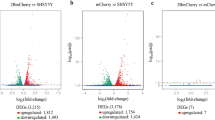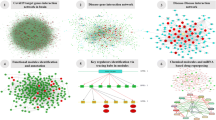Abstract
The chikungunya (CHIKV) viral infection is a global health burden characterized by the neurologic complications with CHIKV infection. CHIKV has relation with Ebola, Dengu, Semlikhi Forest Virus (SLFV) characterized by inflammations in these viral diseases. The present study aimed to discover molecular signatures for comorbidity of viral infections. So, in our study, we have analyzed transcriptome datasets related to viral diseases namely, CHIKV, Ebola, Dengu, SLFV, and inflammatory disorder “Pain” associated with these viral diseases. We built relationship networks based on the CHIKV virus after identifying shared genes among the illnesses mentioned above. After that we also constructed protein-protein interaction network (PPI) considering the differentially expressed genes (DEGs) of CHKIV and identified hub genes based on topological analysis. A total 500 DEGs was identified associated with CHIKV infections induced transcriptomic alterations. It was also found that 105 genes were common in both CHIKV and ebola infections. However, CHIKV shared under 24 significant transcripts with other alphaviruse infections. We also found that 49 genes shared with pain. In our analysis, we identified the relation of these viruses, common genes among them, comorbidities of CHIKV and Hub genes, significant pathways of CHIKV.







Similar content being viewed by others
References
Aiken WD, Anzinger JJ (2015) Chikungunya virus infection and acute elevation of serum prostate-specific antigen. Case Rep Urol 2015:120535
Amberger J, Bocchini C, Hamosh A (2011) A new face and new challenges for Online Mendelian Inheritance in Man (OMIM®). Hum Mutat 32(5):564–567
Badawi A, Ryoo SG, Vasileva D, Yaghoubi S (2018) Prevalence of chronic comorbidities in chikungunya: a systematic review and meta-analysis. Int J Infect Dis 67:107–113
Barrett T, Wilhite SE, Ledoux P, Evangelista C, Kim IF, Tomashevsky M, Marshall KA, Phillippy KH, Sherman PM, Holko M et al (2012) NCBI GEO: archive for functional genomics data sets-update. Nucleic Acids Res 41(D1):D991–D995
Bordi L, Caglioti C, Lalle E, Castilletti C, Capobianchi MR (2015) Chikungunya and its interaction with the host cell. Curr Trop Med Rep 2(1):22–29
Brazier Y (2015) Mosquito-borne chikungunya virus causes severe brain inflammation. https://www.medicalnewstoday.com/articles/303213.php
Cardona-Ospina JA, Villamil-Gomez WE (2015) Estimating the burden of disease and the economic cost attributable to chikungunya, Colombia, 2014. Trans R Soc Trop Med Hyg 3:793–802 (JCCCHDRMA)
Casswell J (2019) Investigating the role of host TTR-RBPs during SFV4 and MHV-68 infection. The University of Liverpool, Liverpool
Chen LH, Wilson ME (2010) Dengue and Chikungunya infections in travelers. Curr Opin Infect Dis 23(5):438–444
Clémentine S, Frédérik S, TCYMFCSKMLAMLAM (2013) Chikungunya virus-associated long-term arthralgia: a 36-month prospective longitudinal study. PLoS Negl Trop Dis 7:e2137
Fraisier C, Koraka P, BMBMGSPMLSOAMBCLALK (2014) analysis of mouse brain proteome alterations following Chikungunya virus infection before and after appearance of clinical symptoms. PLoS One 9:e91397
Fros JJ, Major LD, Scholte FE, Gardner J, van Hemert MJ, Suhrbier A, Pijlman GP (2015) Chikungunya virus non-structural protein 2-mediated host shut-off disables the unfolded protein response. J Gen Virol 96(3):580–589
Goh KI, Cusick ME, Valle D, Childs B, Vidal M, Barabási AL (2007) The human disease network. Proc Natl Acad Sci 104(21):8685–8690
Henß L, Beck S, Tea W (2016) Suramin is a potent inhibitor of chikungunya and Ebola virus cell entry. Virol J 13:1–8
Hossain MA, Asa TA, Islam SMS, Hussain MS, Moni MA (2019a) Identification of genetic association of thyroid cancer with Parkinson’s disease, osteoporosis, chronic heart failure, chronic kidney disease, type 1 diabetes and type 2 diabetes. In: 2019 5th International Conference on Advances in Electrical Engineering (ICAEE), pp 832–837. IEEE
Hossain MA, Asa TA, Rahman MR, Moni MA (2019b) Network-based approach to identify key candidate genes and pathways shared by thyroid cancer and chronic kidney disease. Inform Med Unlocked 16:100240
Hossain MA, Islam SMS, Quinn JM, Huq F, Moni MA (2019c) Machine learning and bioinformatics models to identify gene expression patterns of ovarian cancer associated with disease progression and mortality. J Biomed Inform 100:103313
Hossain M, Asa TA, Rahman M, Uddin S, Moustafa AA, Quinn JM, Moni MA et al (2020a) Network-based genetic profiling reveals cellular pathway differences between follicular thyroid carcinoma and follicular thyroid adenoma. Int J Environ Res Public Health 17(4):1373
Hossain MA, Asa TA, Huq F, Quinn JM, Moni MA (2020b) A network-based approach to identify molecular signatures and comorbidities of thyroid cancer. In: Proceedings of international joint conference on computational intelligence, pp 235–246. Springer
Hossain MA, Islam SMS, Asa TA, Hussain MS, Rahman MR, Moustafa A, Moni MA (2020c) Identification of genetic links of thyroid cancer to the neurodegenerative and chronic diseases progression: insights from systems biology approach. In: Proceedings of International Joint Conference on Computational Intelligence, pp 263–274. Springer
Jaffar Hoarau JJ, Bandjee MC (2010) Persistent chronic inflammation and infection by chikungunya arthritogenic alphavirus in spite of a robust host immune response. J Immunol 184:5914–5927 (KTPDTLPYGDBea)
Jelke J, Fros GPP (2016) Alphavirus infection: host cell shut-off and inhibition of antiviral responses. Viruses 8(6):166
Karlas A, Berre S, Couderc T, Varjak M, Braun P, Meyer M, Gangneux N, Karo-Astover L, Weege F, Raftery M et al (2016) A human genome-wide loss-of-function screen identifies effective chikungunya antiviral drugs. Nat Commun 7(1):1–14
Kash JC, Walters KA, Kindrachuk J, Baxter D, Scherler K, Janosko KB, Adams RD, Herbert AS, James RM, Stonier SW et al (2017) Longitudinal peripheral blood transcriptional analysis of a patient with severe Ebola virus disease. Sci Transl Med 9(385)
Kumar S, Nei M, Dudley J, Tamura K (2008) MEGA: a biologist-centric software for evolutionary analysis of DNA and protein sequences. Brief Bioinform 9(4):299–306
Kunes P, Holubcova Z, Kolackova M, Krejsek J (2012) Pentraxin 3 (PTX 3): an endogenous modulator of the inflammatory response. Mediat Inflamm 2012:920517
Kwissa M, Nakaya HI, Onlamoon N, Wrammert J, Villinger F, Perng GC, Yoksan S, Pattanapanyasat K, Chokephaibulkit K, Ahmed R et al (2014) Dengue virus infection induces expansion of a CD14+ CD16+ monocyte population that stimulates plasmablast differentiation. Cell Host Microbe 16(1):115–127
Larkin MA, Blackshields G, Brown N, Chenna R, McGettigan PA, McWilliam H, Valentin F, Wallace IM, Wilm A, Lopez R et al (2007) Clustal W and Clustal X version 2.0. Bioinformatics 23(21):2947–2948
Marcin K, Nakaya HI, Onlamoon N, Jens W, Francois V, Perng GC, Yoksan S, Pattanapanyasat K, Chokephaibulkit K, Rafi A et al (2014) Dengue virus infection induces expansion of a CD14 CD16 monocyte population that stimulates plasmablast differentiation
Moni M, Lio P (2016) Infectome, diseasome and comorbidities of Zika infection. Int J Infect Dis 53:14
Moni MA, Lio P (2017) Genetic profiling and comorbidities of Zika infection. J Infect Dis 216(6):703–712
Mutsuddy P, Tahmina Jhora S, Shamsuzzaman AKM, Kaisar S, Khan MNA (2019) Dengue situation in Bangladesh: an epidemiological shift in terms of morbidity and mortality. Can J Infect Dis Med Microbiol 2019:3516284
Navratil V, de Chassey B, Combe CR, Lotteau V (2011) When the human viral infectome and diseasome networks collide: towards a systems biology platform for the aetiology of human diseases. BMC Syst Biol 5(1):1
Oliver GF, Carr JM, Smith JR (2019) Emerging infectious uveitis: chikungunya, dengue, Zika and Ebola: a review. Clin Exp Ophthalmol 47(3):372–380
Pialoux G, Gaüzère BA, Jauréguiberry S, Strobel M (2007) Chikungunya, an epidemic arbovirosis. Lancet Infect Dis 7(5):319–327
Poo YS, Rudd PA, GJWJLTCMea (2014) Multiple immune factors are involved in controlling acute and chronic chikungunya virus infection. PLoS Negl Trop Dis 8:e3354
Powers AMLC (2007) Changing patterns of chikungunya virus: re-emergence of a zoonotic arbovirus. J Gen Virol 88:2363–2377
Rezza G (2014) Dengue and chikungunya: long-distance spread and outbreaks in naïve areas cardiovascular manifestations of the emerging dengue pandemic. Pathog Glob Health 108(8):349–355
Salam N, Mustafa S, Hafiz A, Chaudhary AA, Deeba F, Parveen S (2018) Global prevalence and distribution of coinfection of malaria, dengue and chikungunya: a systematic review. BMC Public Health 18(1):1–20
Segura-Cabrera A, García-Pérez CA, Guo X, Rodríguez-Pérez MA (2013) A viral-human interactome based on structural motif-domain interactions captures the human infectome. PloS One 8(8):e71526
Simon F, Javelle E (2015) French guidelines for the management of chikungunya (acute and persistent presentations). Med Mal Infect 45:243–263 (CABETOGGea)
Smith SA, Beaulieu JM, Donoghue MJ (2009) Mega-phylogeny approach for comparative biology: an alternative to supertree and supermatrix approaches. BMC Evol Biol 9(1):37
Suhrbier A, Jaffar-Bandjee M-C, Gasque P (2012) Arthritogenic alphaviruses—an overview. Nat Rev Rheumatol 8:420–429
Toegel S, Weinmann D (2016) Galectin-1 couples glycobiology to inflammation in osteoarthritis through the activation of an NF-B-regulated gene network. J Immunol 196(4):1910–1921 (ASWSea)
Van Huizen E, McInerney GM (2020) Activation of the PI3K-AKT pathway by old world alphaviruses. Cells 9(4):970
Weaver SC, Osorio JE (2012) Chikungunya virus and prospects for a vaccine. Expert Rev Vaccines 11:1087–1101 (LJCRSD)
Werneke S (2013) A role for interferon stimulated gene-15 (ISG15) during chikungunya virus infection
Yacoub S, Wertheim H, Simmons CP, Screaton G, Wills B (2014) Cardiovascular manifestations of the emerging dengue pandemic. Nat Rev Cardiol 11(6):335
Zhou G, Soufan O, Ewald J, Hancock RE, Basu N, Xia J (2019) NetworkAnalyst 3.0: a visual analytics platform for comprehensive gene expression profiling and meta-analysis. Nucleic Acids Res 47(W1):W234–W241
Author information
Authors and Affiliations
Corresponding authors
Ethics declarations
Conflict of interest
We have no conflict of interest.
Additional information
Publisher's Note
Springer Nature remains neutral with regard to jurisdictional claims in published maps and institutional affiliations.
Rights and permissions
About this article
Cite this article
Zhu, L., Wang, X., Asa, T.A. et al. Identification of key genes, pathways, and associated comorbidities in chikungunya infection: insights from system biology analysis. Netw Model Anal Health Inform Bioinforma 10, 57 (2021). https://doi.org/10.1007/s13721-021-00331-5
Received:
Revised:
Accepted:
Published:
DOI: https://doi.org/10.1007/s13721-021-00331-5




